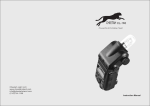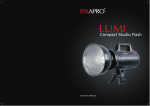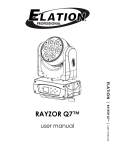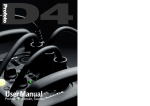Download NOVA Photographic Society – Flash Workshop Outline 01
Transcript
NOVA Photographic Society – Flash Workshop Outline 01/10/2012 This will be a hands-on workshop for beginner and intermediate users alike. We will focus on a single flash unit as a creative tool to enhance your skills as a photographer. We will cover the basics of using a single on-camera portable flash (speed light) and briefly introduce multiple flash units. Examples and demonstration will be provided as well as piratical exercises that will be instructor lead in small groups. We will cover how to use bounce flash, light modifiers, flash modes, control exposure, color correction and more. Bring your camera, flash and manuals for each. Optionally, some foam core sheets or mat sheet scraps (white and/or black) to use as reflectors/flags and a subject such as a small or medium size object you would like to photograph. Materials and References to bring: DSLR and user manual (if available) Separate Flash Unit and user manual (if available) One or more small objects to photograph (optional) White Foam Core 1 full or a few partial sheets to share if possible (optional) 6” x 9” manila envelope and/or similar size piece of white cardboard Small Flashlight or left over Halloween light stick (optional) Light duty tripod (optional) Terms when talking about light: Sources of light: • Direct, sun, bare flash tube, bare light bulb • Reflected / diffused, lamp shade Character of light: • Direction (will travel in a straight line in an ever expanding/ widening cone, will reflect at corresponding angle) • Dispersion / Some light will scatter in all directions • Color (temperature) • Intensity • Hard (small source) more detail, hard shadows. • Soft / diffused (large source) less detail, grey zones. Types of ambient Light (available light) • Tungsten AKA incandescent light bulb (warm) • Fluorescent fight fixtures (traditionally green) many now. • Sunlight –warm, neutral, cool (orange, white, blue) • Mixed light. Light Modifiers: • Umbrella / Softbox (soften) • Reflector – (redirect and soften) • Scrim / translucent panel (soften) • Snoot / grid (focus - hard light) • Bounce card (redirect and soften) • Gels – color correction / special effects Environmental light modifiers: • Walls (white or off white- watch out for colored surfaces) • Ceilings (white) • Floors, Table Cloth, other Inverse square law: Don’t worry it just means that light from your flash will fall off very quickly leaving objects further away less or not at all effected by your flash unit. Most flash photography is a double exposure – some of the image exposed by flash and some by ambient light. Not always the case Example: Dark Pallet Exposure: Can be controlled by 4 adjustable functions on any DSLR used with Flash. • Aperture- Overall Exposure (Flash and available light) • Shutter Speed- Available light only • ISO - Overall Exposure (Flash and available light) • Flash Output Settings - Flash Only Flash exposure compensation, can be set on camera or flash unit – generally best to pick one to work with. Flash Bracketing: Similar to exposure bracketing (set on camera – not flash unit) Flash Exposure Lock, FV lock or Flash Value Lock (set on camera – not flash unit) Locks in a flash setting (flash duration or flash power) and stops the normal pre-flash on TTL mode(s) for every shot. Uses: • Lock in value for off center subject – recompose and shoot • People Portraits – prevent ‘blinking’ • Critters – prevent ‘flinching’ Discus Camera Settings for Exposure or FV Lock: • Programmable buttons on some cameras. o (FV Lock) o (Cancel Flash Value Lock) Discus programming a button to turn flash off for test shot or you decide you do not want flash to fire for a specific shot(s) ` On-camera flash unit: For this class we will be using only TTL and TTL BL. Really, this is all you need. Modes/Settings: Initial Settings On Camera: Front Curtain Sync (normal – fill flash) Slow Sync (burn in dark background) Rear Curtain Sync (action such as light trails) Slow Sync/Rear Curtain (flash and blur) Red Eye Reduction (pre flashes or focus assist illuminator) High Speed FP (flash pulse) Explain how the curtain works. Flash compensation setting +/- 1-2 stops min. Flash Sync Speed & High Speed Sync. (highest shutter speed all modes) Flash Shutter Speed (lowest shutter speed)* *Aperture Priority, Program, Auto mode Possible Modes Available On Flash Unit: (varies by model) TTL (Through-The-Lens -expose for subject only) • Camera flash meter determines flash duration • Fill flash (comp -1.5 to -2.0 stops under overall exposure to lighten shadows on subject) • Use Spot or Center Weighted Metering TTL BL (Through-The-Lens-Balanced –expose for entire scene) • Camera flash meter determines flash duration • Fill flash-pseudo (entire subject in shadow (backlit)) • Use Matrix Metering AA (Aperture Auto - existed before and surpassed by TTL - uses sensor on the flash unit to determine flash duration) M Manual Mode 1/128 to Full Power existed before and surpassed by auto – Use for wireless multiple flash units with flash meter to determine aperture. GN used to calculate ISO and F stop. Example: Guide Number / Distance = f stop GN118 (rated @100 ISO) / 12’ = f9.8 ISO Factors: (Note: As you raise ISO your flash gains power) 100 = 1 200 = 1.5 400 = 2 800 = 3 1600 = 4.25 3200 = 6.25 Note: guide numbers are different for various focal lengths on flashes with zoom heads. Greater zoom increases GN value Optically triggered Flash Example: Nikon SU-4 type. Nikon built in optical trigger on some units. Must use manual flash mode NOT TTL. Flash unit triggered by any other flash does not depend on master flash unit. Still used in high speed stop action photography such as breaking a rack of balls on a pool table. This is also useful for in a wireless setup where a flash unit cannot see the master unit but ‘sees’ another remote unit. (Inexpensive universal optical triggers are available for most flash heads regardless of brand) Inexpensive slave units such as Morris are optically triggered by on camera flash and output a fixed value. These are mostly 115v units with a standard screw-in light bulb base. (great for lighting backgrounds). Note: will be triggered by pre-flash. Take a few minutes to familiarize yourself with: Single, Master, Remote if applicable (We want Single or just ‘on’ for now) Zoom: Wide – Telephoto (manual override or auto) Set illumination pattern = STD (STD, CW, Even) Flip down ‘diffuser’ and slide out card. (some models) Tilt and Rotate Features. (some models) Exercises: Break up into groups of 4-6, more experienced photographers please disperse among groups. Camera Settings: Manual F5.6 (or wider), 1/125th ISO fixed or auto 100-1600 your call. Front Curtain Sync. Flash sync speed 125 or greater. Flash shutter speed 1/60 (won’t really matter for now) Flash Settings: TTL mode, Flash compensation = 0, We will test this out together for a few minutes, metering on the ceiling, light fixtures etc. Brief discussion about the cameras metering systems and difference between flash and exposure metering. OK lets get to work… remember to review your photos as you go. Note how TTL flash metering and ISO settings control exposure for you. Try Direct Flash vs Bounce Flash using walls and ceilings compare to direct flash. Photograph group members and objects. Note shadows under eyes, nose, chin, etc. use a small piece of foam core or other material to make a gobo to ‘flag’ the flash unit so no direct light falls on the subject. Use your bounce cards to direct some light forward. Hand hold or use the pop up bounce card and reflect some light forward while bouncing the flash off the ceiling or wall (you will be creating 2 light sources from one flash) ‘show’ more or less of the card to see the effect. If you have one, use a small manila envelope to create warm light on your subject. 3. Use bounce card with camera in vertical (portrait) orientation. Rotate the flash head so it is pointing behind you and up at about a 45 degree angle. Try bouncing above and behind you (corner of wall and ceiling) to light a subject in front of you. Place a small object on foam core and aim the flash straight up or so the flash bounces back just in front of the object on the foam core. Use smaller pieces to reflect light to fill in shadows or bring out highlights. Zoom the flash head to something other than your lens focal length. Example: lens 24mm – Flash head 125mm or more to test the effect – then reverse. Note how the light fills the room or highlights the subject. Change angle of the flash head. Try to bounce in front of, behind, to left and right of your subject and note the results. Use the flash head to make the light come from somewhere else. Note camera position in relation to the angle of the flash head. (if you point the flash head straight up but tilt the camera – what happens? Photograph both near and far objects in the room. Try different bounce angles. Also note how the flash quickly looses power (fades) and the effect on distant objects. Change both exposure compensation and flash compensation up and down and note results. Particularly note ISO and overall exposure vs amount of flash effect you see in you photo. Set your ISO to a fixed value the emphasize the effect. Change from TTL to TTL BL and try spot metering to center weighted to matrix metering and note the difference. Then switch back. Change your shutter speed and aperture and note the differences. Which causes you flash to ‘loose’ or ‘gain’ power? Can you go over 125th second in manual? If not, why? Note: Check Flash Sync Speed Setting. Try Slow Sync flash. Lower you speed until your meter shows a dark background is properly exposed. Try a smaller aperture such as 8 or 11 to get a 2-3 second exposure. Make sure you are in TLL and you meter on your subject, steady your camera on a tripod or table etc. Try Rear Curtain Sync. Advice: To begin open your lens/ slow your shutter and raise your ISO. First leave your camera in front curtain sync and have someone walk quickly in front of you carrying a small flashlight or light stick. Take a photoNote if the light trail is in front or behind. If you do not see the effect, switch to Slow Sync and lower your shutter speed more. Then try the same exercise with Rear Curtain and/or Slow Sync/Rear Curtain and note the difference. Try to vary your aperture, ISO and shutter speed to get the effect you like. Switch to Aperture Priority noting flash sync speed and shutter speed settings. 17. Try shutter priority to a DIY slow sync flash in the normal mode. OK you’re done -Celebrate and congratulate yourself!














